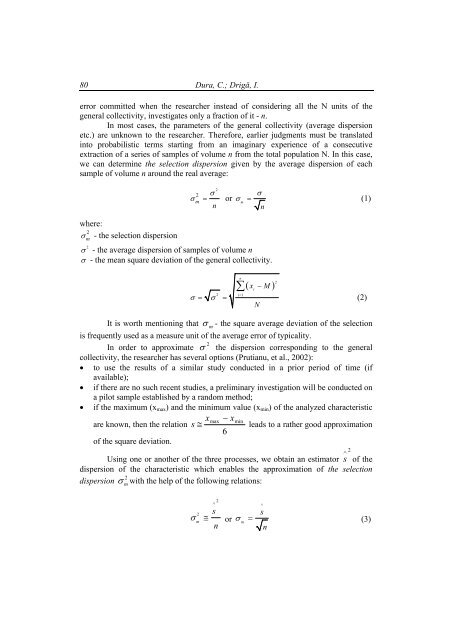annals of the university of petroÅani â¼ economics â¼ vol. xi - part i ...
annals of the university of petroÅani â¼ economics â¼ vol. xi - part i ...
annals of the university of petroÅani â¼ economics â¼ vol. xi - part i ...
You also want an ePaper? Increase the reach of your titles
YUMPU automatically turns print PDFs into web optimized ePapers that Google loves.
80 Dura, C.; Drigă, I.<br />
error committed when <strong>the</strong> researcher instead <strong>of</strong> considering all <strong>the</strong> N units <strong>of</strong> <strong>the</strong><br />
general collectivity, investigates only a fraction <strong>of</strong> it - n.<br />
In most cases, <strong>the</strong> parameters <strong>of</strong> <strong>the</strong> general collectivity (average dispersion<br />
etc.) are unknown to <strong>the</strong> researcher. Therefore, earlier judgments must be translated<br />
into probabilistic terms starting from an imaginary experience <strong>of</strong> a consecutive<br />
extraction <strong>of</strong> a series <strong>of</strong> samples <strong>of</strong> <strong>vol</strong>ume n from <strong>the</strong> total population N. In this case,<br />
we can determine <strong>the</strong> selection dispersion given by <strong>the</strong> average dispersion <strong>of</strong> each<br />
sample <strong>of</strong> <strong>vol</strong>ume n around <strong>the</strong> real average:<br />
where:<br />
σ - <strong>the</strong> selection dispersion<br />
2<br />
m<br />
2<br />
σ - <strong>the</strong> average dispersion <strong>of</strong> samples <strong>of</strong> <strong>vol</strong>ume n<br />
σ - <strong>the</strong> mean square deviation <strong>of</strong> <strong>the</strong> general collectivity.<br />
2<br />
2 σ<br />
σ<br />
σ<br />
m<br />
= or σ = (1)<br />
m<br />
n<br />
n<br />
σ = σ =<br />
n<br />
∑<br />
2 i=<br />
1<br />
( x − M) 2<br />
i<br />
N<br />
(2)<br />
It is worth mentioning that σ<br />
m<br />
- <strong>the</strong> square average deviation <strong>of</strong> <strong>the</strong> selection<br />
is frequently used as a measure unit <strong>of</strong> <strong>the</strong> average error <strong>of</strong> typicality.<br />
2<br />
In order to appro<strong>xi</strong>mate σ <strong>the</strong> dispersion corresponding to <strong>the</strong> general<br />
collectivity, <strong>the</strong> researcher has several options (Prutianu, et al., 2002):<br />
• to use <strong>the</strong> results <strong>of</strong> a similar study conducted in a prior period <strong>of</strong> time (if<br />
available);<br />
• if <strong>the</strong>re are no such recent studies, a preliminary investigation will be conducted on<br />
a pilot sample established by a random method;<br />
• if <strong>the</strong> ma<strong>xi</strong>mum (x max ) and <strong>the</strong> minimum value (x min ) <strong>of</strong> <strong>the</strong> analyzed characteristic<br />
x<br />
are known, <strong>the</strong>n <strong>the</strong> relation max<br />
− x<br />
s ≅ min<br />
leads to a ra<strong>the</strong>r good appro<strong>xi</strong>mation<br />
6<br />
<strong>of</strong> <strong>the</strong> square deviation.<br />
Using one or ano<strong>the</strong>r <strong>of</strong> <strong>the</strong> three processes, we obtain an estimator s <strong>of</strong> <strong>the</strong><br />
dispersion <strong>of</strong> <strong>the</strong> characteristic which enables <strong>the</strong> appro<strong>xi</strong>mation <strong>of</strong> <strong>the</strong> selection<br />
2<br />
dispersion with <strong>the</strong> help <strong>of</strong> <strong>the</strong> following relations:<br />
σ m<br />
∧ 2<br />
σ<br />
2<br />
m<br />
∧<br />
2<br />
∧<br />
s<br />
s<br />
≅ or σ =<br />
m<br />
(3)<br />
n<br />
n

















